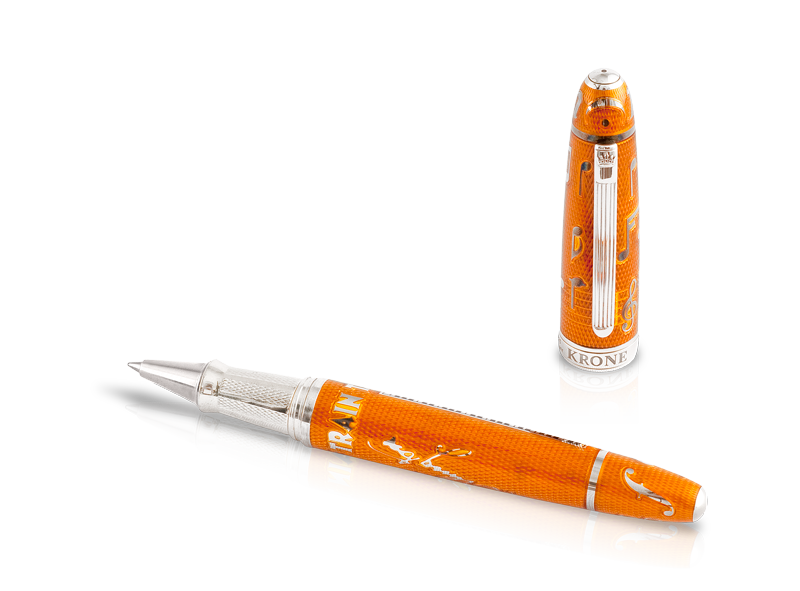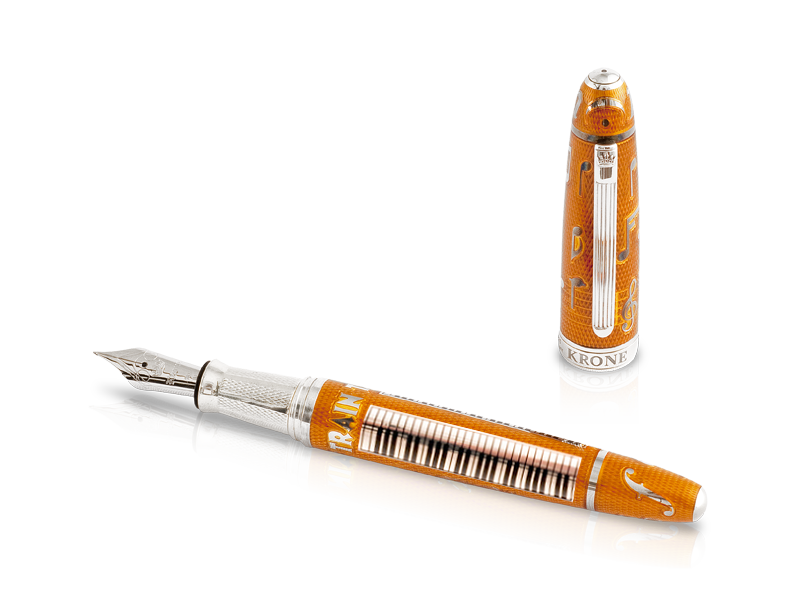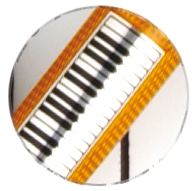Duke Ellington
The Krone Duke Ellington pen is fashioned from .925 solid sterling silver and then lacquered in a lustrous orange finish. Encircling the barrel is Duke Ellington’ signature along with his cherished vehicle of expression, the piano. The notes from his most well know creation, “Take the ‘A’ Train” also adorn this masterpiece.
Available in a worldwide Limited Edition of 188 fountain pens and 38 rollerballs.
Cartridge or Converter. F and M.
| GALLERY | CONFECTIONING |
Jazz may have meant freedom of expression to the young Duke Ellington, but in the early 1920s it was a controversial art form that portended social change and scared many middle class Americans, both black and white. The decade that became known as the "Roaring Twenties" became a battleground for modern ideas and established social convention. Moralists of the era drew a close link between jazz music, public dancing, profanity, promiscuous sex and substance abuse. Nothing short of the decline and fall of western civilization was being linked to jazz music. This fear was exacerbated by the popularity of such black-influenced dances as The Charleston, which became a national craze between 1923 and 1926. So while jazz and public dancing were viewed as decadent, they were also fun and alluring.
Duke Ellington stood at the nexus of this controversy when he arrived in Harlem in the early 1920s and became an integral part of the artistic revolution known as the "Harlem Renaissance". By the middle of the decade Ellington had a nicely evolving sound and had developed his chops playing the piano at all-night rent parties. He then got two big career breaks in rapid succession. In the fall of 1926 he met Irving Mills, an innovative New York music publisher who was scouting talent when he sawEllington at the Club Kentucky. Mills started recording Ellington' orchestra immediately and brought wide exposure to his music through recordings, radio play and movies. The second break came a year later, when the renowned Harlem Cotton Club was looking for a new house band. Ellington auditioned for the job and started what would become a 38 month engagement at the club, between 1927 and 1931. During this time Ellington composed a lot of new music and became a public figure, all the while playing six to seven nights a week at a club run by bootlegging white gangsters. But the work was steady and the pay was good, which provided a perfect laboratory for Ellington to develop his sound more fully.
In the late 1930s Ellington met the man who would become his main collaborator and musical soul mate, Billy Strayhorn. Strayhorn had approached the bandleader after a performance in Pittsburgh and shown him some work. Ellington was so impressed that he brought Strayhorn to New York two months later to be his lyricist. Strayhorn' classical training allowed him to fully assimilate and master what he later called the "Ellington Effect" and the two men produced a string of classic jazz recordings in the early 1940s that included Duke Ellington' signature song, "Take the 'A' Train", which was also viewed as Strayhorn' breakthrough composition.
As Duke Ellington evolved from controversial jazz innovator to bonafide musical genius to cultural icon, he found himself at Richard Nixon' White House in 1969 to celebrate his 70th birthday. Nixon aide Leonard Garment, later a key figure in the Watergate scandal, was a former clarinetist in Woody Herman's band, and had arranged for Ellington' party at the White House. In a building where most black people had historically entered through the servants' quarters, including Ellington' own father, Duke Ellington received the Presidential Medal of Freedom, the nation' highest civilian honor. After the Nixons went to bed there was a jam session and dancing until 2am. In a night fraught with emotion and irony, Duke Ellington remained a jazzman to the end.
LISTEN TO AUDIOThe Krone Duke Ellington pen is fashioned from .925 solid sterling silver and then lacquered in a lustrous orange finish. Encircling the barrel is Duke Ellington’ signature along with his cherished vehicle of expression, the piano. The notes from his most well know creation, “Take the ‘A’ Train” also adorn this masterpiece.
Available in a worldwide Limited Edition of 188 fountain pens and 38 rollerballs.
Cartridge or Converter. F and M.
| GALLERY | CONFECTIONING |



